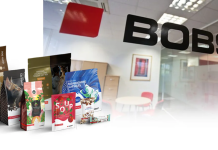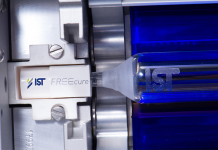The world of packaging is changing. The hedonistic throw away culture of years gone by, where plastic was king, is already a fading memory. The future sees a rejection of the practices that poison our oceans and contaminate our land for generations, instead favouring the recyclable and the sustainable. John Corrall, Managing Director of Industrial Inkjet Limited, discusses how pulp is leading the way in this revolution.
Pulp is made from recycled cellulose, sugar cane or even grass. It has a multitude of potential uses, from internal packaging for electronics to egg boxes, disposable plates to fruit punnets, it can be used for salad boxes or even detergent packs. It can be light but strong and can even be made grease-proof.
The next question is how to decorate these new packages. Nothing looks more drab on a shelf than endless grey or brown packages, so they need to look brightly-coloured and appealing. However, any decoration has to de-ink easily for recycling. For long production runs, flexo is currently used, but for short runs or runs with a lot of variation (for example different types of fruit in the same size punnet) this can mean that more pulp cartons are used for setup than in production (hardly a green solution). Using labels is then the logical alternative, but these can cost more than the pulp carton itself, potentially ruining the commercial viability. So what if an alternative was possible? Print direct to the pulp carton using economic and safe water-based inks in vivid colours? Surely that would be the perfect solution? And in order to achieve this goal, what are the technical challenges to be overcome?
The Right Ink
As with most inkjet projects, the printing hardware has to be right, but the ink is the key. Without the right ink, no project will ever succeed. In the case of pulp packaging, the demands on the ink are widespread:
Bright colours: it’s obvious that bright or strong colours will be needed – but they need to remain bright on what is often a very absorbent material. The water content of the ink may be absorbed quickly, but the pigment needs to stay on or near the pulp surface. Also the carton material itself may be an off-white colour or may be pre-coloured (grass-based pulp packaging is – not surprisingly – green in colour).
Regulatory Requirements: if the carton will be used to hold food then the relevant regulation is EC1935/2004. For the printing ink most customers expect compliance with Swiss Ordinance SR 817.023.21. This regulation defines the materials that may be used in a printing ink for ‘non-direct food contact’. There are tests to check what will migrate out of the ink and into any food contained. We need to worry not just about ink that penetrates through the carton wall from the outside to the inside, but also any cross-contamination between the ink on the outside of a carton and the inside of the carton below it when they are stacked together.
Cost: as ever, the economics will make or break the project. Inkjet ink is always going to be more expensive per-litre than flexo ink but this is compensated for by the lack of setup time (and therefore setup cost) and the lack of waste during setup. The economics will obviously change a lot depending on the extent of the decoration required. For example, the cost of printing a small picture of a strawberry or a plum, plus some text and a barcode, might be only 10% of the cost of decorating the entire top and sides of the carton.
Pulp Media Type: ‘Normal’ water-based inks usually work well on regular pulp cartons. The problem comes with grease-proof cartons that have had the pulp material treated with a hydrophobic coating. The ink simply sits on the surface of the carton and can easily be ‘smudged’ with a finger. With this kind of material, we can use a pre-treatment such as a primer to help fix the ink. Or we can use an alternative ink such as a water-based polymeric ink that will ‘fix’ to the pulp surface when heated. In either case, there is an additional cost to be considered.
Inkjet System
As with any inkjet hardware to be used in-line in a production environment, the system will need to be very reliable. After that there are several aspects to decorating pulp cartons that are a little unusual:
Orientation: high-quality colour inkjet print in an industrial environment usually uses piezo drop-on-demand technology. These inkjet print heads have open nozzle holes and the ink is prevented from falling out by careful application of a small vacuum to the ink supply system. This works fine when printing downwards (for example onto the carton lid) because all of the nozzles in the inkjet print head are at the same height and see the same pressure.
However, when printing cartons such as fruit punnets, we need to print both sides of the punnet at more or less the same time. The inkjet print heads are now in ‘tower’ mode, i.e. the row of nozzles is vertically upwards. The nozzles shoot sideways onto the sides of each punnet as it moves horizontally past. The ink pressure at the top of the print head is always going to be less than the ink pressure at the bottom of the print head. For this to work we need a print head with a wide ‘pressure window’. A combination of the non-wet coating on the inkjet print head, and the shape of the tiny nozzle cone, allows the ink meniscus to survive a significant change in ink pressure along the length of the print head.
Ink Throw Distance: pulp cartons usually have a textured surface and are not highly accurate in their overall dimensions. There may be individual paper fibres sticking up. They also tend to have steps or lips in their design in order to add strength. All of this means that the inkjet print head cannot get close to the carton or there is likely to be a crash. From our experience at IIJ, we are normally asking the inkjet print head to ‘throw’ the ink drops between 3 and 5mm to the carton surface. To an extent this conflicts with the customer’s desire for the highest possible print quality. High quality print needs small ink drops, but small ink drops won’t fly far before they lose momentum and blow away. The best compromise seems to be around 14pL drop size. Quality is still rated as ‘good’ but we can print well onto cartons with curved or stepped surfaces.
Environment
Dust: Pulp carton is dusty. Dust gets onto the inkjet print head nozzle faces and interferes with jetting. This causes missing nozzles in the print and production has to pause while the print heads are cleaned. The most important thing to consider is how to prevent dust reaching the inkjet print heads in the first place. Airflow is very important, so an air-knife may be used to remove dust from the carton well before it approaches the inkjet, and the area around the inkjet might be kept at a positive air pressure. It’s also important that when cleaning of the print heads is eventually required, the process is very quick and minimises down-time.
Heat and humidity: if we are printing the cartons soon after manufacture then we have hot, wet cartons passing close to the inkjet heads. The heat could potentially cause drying of the ink in the nozzles, while the humidity could cause condensation i.e. water droppings forming on the cooler inkjet print heads. As with dust issues, the solution involves airflow. Gently blow away the warm, wet air and the problems are resolved.
Drying
Drying of the printed ink should not be forgotten. Our experience is that on dry cartons a near infra-red (NIR) lamp is an effective solution for drying the ink. However, if the decoration is to be done in-line directly after carton manufacture then the situation is different. In that case, the pulp is still wet – perhaps around 7% water by weight depending on the manufacturing process.
Since the ink is water-based, this doesn’t seem to impact print quality – but it does make drying difficult since in effect the dryer is drying the carton as well as the ink. In this case we have found that hot air can work very well (although it takes up a lot of space).
Demand for pulp carton is about to explode, and the use of inkjet for decoration may well be the ‘next big thing’ for our industry.





















